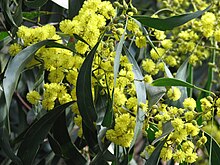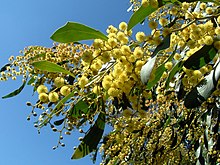
Acacia cultriformis, known as the knife-leaf wattle, dogtooth wattle, half-moon wattle or golden-glow wattle, is a perennial tree or shrub of the genus Acacia native to Australia. It is widely cultivated, and has been found to have naturalised in Asia, Africa, North America, New Zealand and South America. A. cultriformis grows to a height of about 4 m (13 ft) and has triangle-shaped phyllodes. The yellow flowers appear from August to November in its natural range. Its attractive foliage and bright flowers make it a popular garden plant.

Acacia saligna, commonly known by various names including coojong, golden wreath wattle, orange wattle, blue-leafed wattle, Western Australian golden wattle, and, in Africa, Port Jackson willow, is a small tree in the family Fabaceae. Native to Australia, it is widely distributed throughout the south west corner of Western Australia, extending north as far as the Murchison River, and east to Israelite Bay. The Noongar peoples know the tree as Cujong.

Acacia acuminata, commonly known as raspberry jam, jam or jam tree is a species of flowering plant in the family Fabaceae and is endemic to the south-west of Western Australia. It is a tree with linear to narrowly elliptic phyllodes, spikes of golden-yellow flowers and papery to leathery pods.
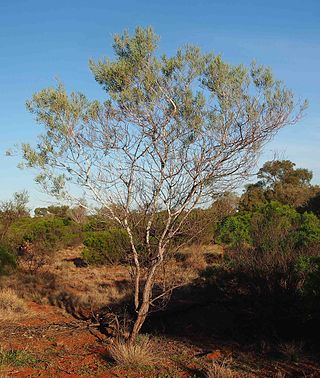
Acacia murrayana is a tree in the family Fabaceae. It has numerous common names, including sandplain wattle, Murray's wattle, fire wattle, colony wattle and powder bark wattle, and is endemic to arid areas in every mainland state except Victoria.

Acacia implexa, commonly known as lightwood or hickory wattle, is a fast-growing Australian tree, the timber of which is used for furniture making. The wood is prized for its finish and strength. The foliage was used to make pulp and dye cloth.

Acacia decurrens, commonly known as black wattle or early green wattle, is a perennial tree or shrub native to eastern New South Wales, including Sydney, the Greater Blue Mountains Area, the Hunter Region, and southwest to the Australian Capital Territory. It grows to a height of 2–15 m (7–50 ft) and it flowers from July to September.

Acacia longifolia is a species of Acacia native to southeastern Australia, from the extreme southeast of Queensland, eastern New South Wales, eastern and southern Victoria, southeastern South Australia, and Tasmania. Common names for it include long-leaved wattle, acacia trinervis, aroma doble, golden wattle, coast wattle, sallow wattle and Sydney golden wattle. It is not listed as being a threatened species, and is considered invasive in Portugal, New Zealand and South Africa. In the southern region of Western Australia, it has become naturalised and has been classed as a weed by out-competing indigenous species. It is a tree that grows very quickly reaching 7–10 m in five to six years.
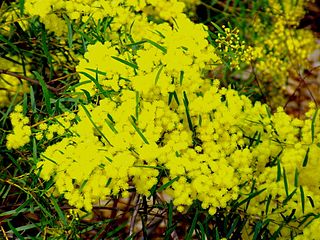
Acacia fimbriata, commonly known as the fringed wattle, Brisbane golden wattle, or just the Brisbane wattle, is a species of Acacia that is native to much of the east coast of Australia. It is one of the floral emblems of the city of Brisbane, Queensland.
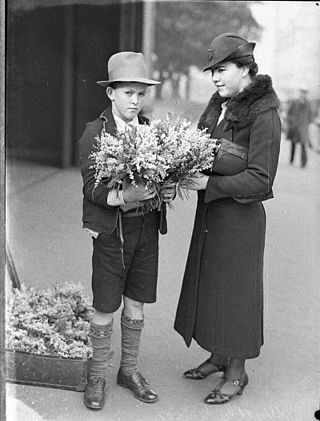
Wattle Day is a day of celebration in Australia on the first day of September each year, which is the start of the Australian spring. This is the time when many Acacia species, are in flower. So, people wear a sprig of the flowers and leaves to celebrate the day.

Acacia gunnii, commonly known as ploughshare wattle or dog's tooth wattle, is a woody shrub which is endemic to south-eastern Australia found in dry heaths and woodlands. It ranges from Queensland, then New South Wales, Australian Capital Territory, Victoria, South Australia, down to Tasmania. Acacia gunnii grows to up to 1 metre high and has prickly phyllodes which are 4 to 15 mm long. The cream to pale yellow globular flowerheads appear singly in the axils of the phyllodes in June to October, followed by curved or coiled seed pods which are 40 mm long and 4 to 5 mm wide. Acacia gunnii grows up to 1 meter tall and has prickly phyllodes which are 4 to 15mm in length with cream to pale-yellow globular flower heads appearing in phyllode axils in June through to October, followed by curved or coiled seed pods which are 40mm long and 4 to 5 mm wide. The species was first formally described by English botanist George Bentham in the London Journal of Botany in 1842. It occurs in South Australia, Victoria, Tasmania, New South Wales, Australian Capital Territory, and Queensland.

Acacia prominens is a shrub or tree in the genus Acacia native to New South Wales, Australia.

Acacia pubescens, also known as the downy wattle, is a species of wattle found in the Sydney Basin in eastern New South Wales. The downy wattle is classified as vulnerable; much of its habitat has vanished with the growth of the city of Sydney. As with all wattles, it has compound (pinnate) leaf stems.

Acacia bynoeana, known colloquially as Bynoe's wattle or tiny wattle, is a species of Acacia native to eastern Australia. It is listed as endangered in New South Wales and as vulnerable according to the Environment Protection and Biodiversity Conservation Act 1999.

Acacia leiophylla, commonly known as coast golden wattle, is a tree of the family Mimosaceae native to South Australia and Western Australia.

Acacia hakeoides, known colloquially as hakea wattle, hakea-leaved wattle or western black wattle, is a species of flowering plant endemic to southern Australia. It is a bushy shrub or tree with lance-shaped to linear phyllodes, racemes of bright golden-yellow flowers and more or less leathery to leathery to hard and brittle pods. It can be found growing in sandy soils in semiarid and Eucalyptus woodland in the region.

Trichilogaster signiventris, commonly known as the golden wattle bud-galling wasp, is a species of Australian chalcid wasps that parasitises, among others, Acacia pycnantha. It has been introduced into South Africa, where the golden wattle has become an invasive pest.

Acacia iteaphylla, commonly known as Flinders Range wattle, Port Lincoln wattle, winter wattle and willow-leaved wattle, is a shrub belonging to the genus Acacia and the subgenus Phyllodineae that is endemic to South Australia.
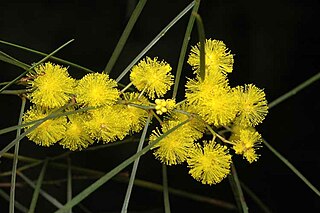
Acacia adunca, commonly known as Wallangarra wattle or cascade wattle, is a species of flowering plant in the family Fabaceae and is endemic to eastern Australia. It is an erect, bushy shrub or tree with narrowly linear phyllodes, racemes of spherical bright golden flowers, and leathery pods.

Acacia dictyocarpa is a shrub belonging to the genus Acacia and the subgenus Phyllodineae that is endemic to south eastern Australia.

Acacia leptostachya, commonly known as Townsville wattle or slender wattle, is a shrub or small tree belonging to the genus Acacia and the subgenus Juliflorae that is native to north eastern Australia.
